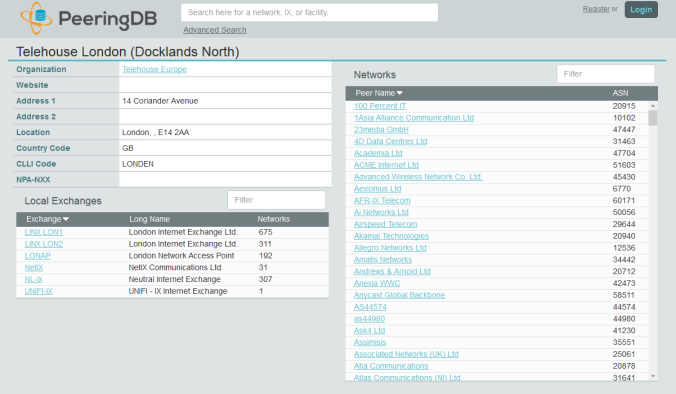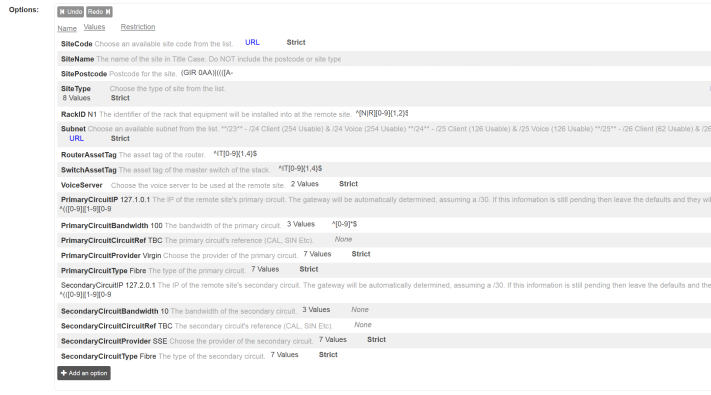If you come from a Cisco Quality of Service (QoS) background then you may find converting to the way that Juniper does things a challenge at first. As an initial step, I can recommend the free Juniper e-book entitled ‘Junos QoS For IOS Engineers‘. The first thing to know is that Juniper call it Class of Service (CoS). In Cisco land, the term ‘CoS’ is used exclusively for layer 2 (802.1q) QoS, so this can be confusing initially.
As with my other Juniper posts, the configuration will be for an MX104 router. The MX series supports 16 forwarding classes and 8 output queues, which allows you to classify packets with more granularity. As there can be more forwarding classes than queues, if you configure more than 8 forwarding classes you must map multiple forwarding classes to single output queues.
We’ll be using the traffic classes that are described in RFC4594, ‘Configuration Guidelines for DiffServ Service Classes’. If you’ve seen any of the Cisco Live presentations about QoS in the last few years, then the mapping below may look familiar.
First of all we need to define our 12 RFC4594 forwarding classes and then map them to the 8 output queues as per our diagram above. You will notice that some of the classes are mapped to the same queue. You may wonder why we are using more forwarding classes than there are queues available. This particular device supports 8 queues, but other devices on the network support more. We can therefore keep the application classes and DSCP markings consistent across the network but then simply map them to the supported number of queues at each hop.
set class-of-service forwarding-classes class voip-telephony queue-num 0 set class-of-service forwarding-classes class broadcast-video queue-num 0 set class-of-service forwarding-classes class real-time-interactive queue-num 0 set class-of-service forwarding-classes class network-control queue-num 1 set class-of-service forwarding-classes class signalling queue-num 1 set class-of-service forwarding-classes class ops-admin-mgmt queue-num 1 set class-of-service forwarding-classes class multimedia-conferencing queue-num 2 set class-of-service forwarding-classes class multimedia-streaming queue-num 3 set class-of-service forwarding-classes class transactional-data queue-num 4 set class-of-service forwarding-classes class bulk-data queue-num 5 set class-of-service forwarding-classes class scavenger queue-num 6 set class-of-service forwarding-classes class best-effort queue-num 7
Next we must classify traffic that has already been marked. This is a core device, so ideally we want to have marked our traffic at an earlier point in the network. As we can simply look at existing DSCP markings, we can use what’s called a Behaviour Aggregate (BA) classifier. If we wanted to classify based upon IP addresses and ports, we could use a multifield classifier along with a firewall filter.
set class-of-service classifiers dscp ba-classifier-rfc4594 forwarding-class voip-telephony loss-priority high code-points ef set class-of-service classifiers dscp ba-classifier-rfc4594 forwarding-class broadcast-video loss-priority high code-points cs3 set class-of-service classifiers dscp ba-classifier-rfc4594 forwarding-class real-time-interactive loss-priority high code-points cs4 set class-of-service classifiers dscp ba-classifier-rfc4594 forwarding-class multimedia-conferencing loss-priority high code-points [ af41 af42 af43 ] set class-of-service classifiers dscp ba-classifier-rfc4594 forwarding-class multimedia-streaming loss-priority high code-points [ af31 af32 af33 ] set class-of-service classifiers dscp ba-classifier-rfc4594 forwarding-class network-control loss-priority high code-points [ cs6 cs7 ] set class-of-service classifiers dscp ba-classifier-rfc4594 forwarding-class signalling loss-priority high code-points cs5 set class-of-service classifiers dscp ba-classifier-rfc4594 forwarding-class ops-admin-mgmt loss-priority high code-points cs2 set class-of-service classifiers dscp ba-classifier-rfc4594 forwarding-class transactional-data loss-priority high code-points [ af21 af22 af23 ] set class-of-service classifiers dscp ba-classifier-rfc4594 forwarding-class bulk-data loss-priority high code-points [ af11 af12 af13 ] set class-of-service classifiers dscp ba-classifier-rfc4594 forwarding-class scavenger loss-priority high code-points cs1 set class-of-service classifiers dscp ba-classifier-rfc4594 forwarding-class best-effort loss-priority high code-points be
In the above configuration we are creating a BA classifier named ‘ba-classifier-rfc4594’ and then assigning our DSCP markings (EF, CS1, AF11 etc) to each of the forwarding classes that we defined earlier.
Loss priorities allow us to specify different drop profiles for certain types of traffic. Drop profiles tell the router how to drop packets when an interface is congested. For simplicity we keep the loss priority set to high for all forwarding classes. We will reference this ‘high’ value later and assign a drop profile.
Once the classifier is complete, we must apply it to each interface that will receive traffic that has already been marked. If you are using sub interfaces, the classifier should be applied to each sub-interface and not to the physical interface.
set class-of-service interfaces ge-0/1/0 unit 210 classifiers dscp ba-classifier-rfc4594 set class-of-service interfaces ge-0/1/0 unit 211 classifiers dscp ba-classifier-rfc4594 set class-of-service interfaces ge-0/1/1 unit 210 classifiers dscp ba-classifier-rfc4594 set class-of-service interfaces ge-0/1/1 unit 211 classifiers dscp ba-classifier-rfc4594
So far we have our forwarding classes which have been mapped to queues. We have a BA classifier that will inspect the DSCP markings on incoming packets and put them in the correct forwarding class. We now need to allocate available bandwidth across those queues using a scheduler.
You can think of a scheduler as a cashier that is servicing multiple queues of customers at once. The cashier will pick two people from queue one, five people from queue two etc. As you can imagine, queue two would reduce in length at a much faster rate than queue one. The number of customers picked from each queue at a time by the cashier would be the bandwidth allocation and the queue that they choose to serve first would be determined by the priority.
set class-of-service schedulers real-time transmit-rate percent 20 set class-of-service schedulers real-time priority high set class-of-service schedulers control transmit-rate percent 10 set class-of-service schedulers control priority medium-high set class-of-service schedulers multimedia-conferencing transmit-rate percent 10 set class-of-service schedulers multimedia-conferencing priority medium-high set class-of-service schedulers multimedia-conferencing drop-profile-map loss-priority high protocol any drop-profile high-drop set class-of-service schedulers multimedia-streaming transmit-rate percent 10 set class-of-service schedulers multimedia-streaming priority medium-high set class-of-service schedulers multimedia-streaming drop-profile-map loss-priority high protocol any drop-profile high-drop set class-of-service schedulers transactional-data transmit-rate percent 10 set class-of-service schedulers transactional-data priority medium-high set class-of-service schedulers transactional-data drop-profile-map loss-priority high protocol any drop-profile high-drop set class-of-service schedulers bulk-data transmit-rate percent 8 set class-of-service schedulers bulk-data priority low set class-of-service schedulers bulk-data drop-profile-map loss-priority high protocol any drop-profile high-drop set class-of-service schedulers scavenger transmit-rate percent 2 set class-of-service schedulers scavenger priority low set class-of-service schedulers best-effort transmit-rate percent 30 set class-of-service schedulers best-effort priority medium-low set class-of-service schedulers best-effort drop-profile-map loss-priority high protocol any drop-profile high-drop
There are a few things to point out in the above configuration. We start by creating 8 schedulers, one for each of the 8 queues supported on the MX series router. These are named according to the queues in the mapping diagram above. Each scheduler is given a certain percentage of the interface bandwidth and a priority.
Priorities determine the order in which queues have access to the outgoing interface. The available priorities are low, medium-low, medium-high, high and strict-high. Strict-high is similar to the priority queue in Cisco land, although as you can only map a single forwarding class to it, we’ve used high here instead.
Some of the schedulers reference a drop profile named ‘high-drop’ that is utilised when a loss-priority of ‘high’ has been set by our BA classifier. We will create this drop profile later on. The drop profiles are associated with queues that contain primarily TCP traffic and that would benefit from Weighted Random Early Detect (WRED).
The individual schedulers now need to be mapped to forwarding-classes with a scheduler map. As we have multiple forwarding-classes tied to certain queues, the forwarding-classes that share a queue must all reference the same scheduler.
set class-of-service scheduler-map scheduler-8q forwarding-class voip-telephony scheduler real-time set class-of-service scheduler-map scheduler-8q forwarding-class broadcast-video scheduler real-time set class-of-service scheduler-map scheduler-8q forwarding-class real-time-interactive scheduler real-time set class-of-service scheduler-map scheduler-8q forwarding-class network-control scheduler control set class-of-service scheduler-map scheduler-8q forwarding-class signalling scheduler control set class-of-service scheduler-map scheduler-8q forwarding-class ops-admin-mgmt scheduler control set class-of-service scheduler-map scheduler-8q forwarding-class multimedia-streaming scheduler multimedia-streaming set class-of-service scheduler-map scheduler-8q forwarding-class multimedia-conferencing scheduler multimedia-conferencing set class-of-service scheduler-map scheduler-8q forwarding-class transactional-data scheduler transactional-data set class-of-service scheduler-map scheduler-8q forwarding-class bulk-data scheduler bulk-data set class-of-service scheduler-map scheduler-8q forwarding-class scavenger scheduler scavenger set class-of-service scheduler-map scheduler-8q forwarding-class best-effort scheduler best-effort
Next, the above scheduler map named ‘scheduler-8q’ needs to be assigned to each interface. This should be the physical interface even if you have sub-interfaces configured.
set class-of-service interfaces ge0/1/0 scheduler-map scheduler-8q set class-of-service interfaces ge0/1/1 scheduler-map scheduler-8q
On transit interfaces where we might not trust the DSCP markings that are set on the incoming packets, we need to enforce the best-effort forwarding class. This prevents untrusted traffic from marking everything as voice (our highest priority queue) and starving our other traffic of bandwidth. To do this we can use a fixed classifier that specifies a single forwarding class that all traffic will be placed into.
set class-of-service interfaces ge0/0/0 unit 0 forwarding-class best-effort
All sorted, right? Well, not really. Although our traffic will leave this router in the correct queue, we haven’t changed the DSCP marking. The next router might use a BA classifier and will classify the traffic based upon the untrusted DSCP marking. To resolve this, we need to define rewrite rules. The important point to note here is that a packet’s DSCP marking is only changed as it leaves the router on the egress interface.
High Loss Priority: set class-of-service rewrite-rules dscp rewrite-rfc4594 forwarding-class voip-telephony loss-priority high code-point ef set class-of-service rewrite-rules dscp rewrite-rfc4594 forwarding-class broadcast-video loss-priority high code-point cs3 set class-of-service rewrite-rules dscp rewrite-rfc4594 forwarding-class real-time-interactive loss-priority high code-point cs4 set class-of-service rewrite-rules dscp rewrite-rfc4594 forwarding-class multimedia-conferencing loss-priority high code-point af41 set class-of-service rewrite-rules dscp rewrite-rfc4594 forwarding-class multimedia-streaming loss-priority high code-point af31 set class-of-service rewrite-rules dscp rewrite-rfc4594 forwarding-class network-control loss-priority high code-point cs6 set class-of-service rewrite-rules dscp rewrite-rfc4594 forwarding-class network-control loss-priority high code-point cs7 set class-of-service rewrite-rules dscp rewrite-rfc4594 forwarding-class signalling loss-priority high code-point cs5 set class-of-service rewrite-rules dscp rewrite-rfc4594 forwarding-class ops-admin-mgmt loss-priority high code-point cs2 set class-of-service rewrite-rules dscp rewrite-rfc4594 forwarding-class transactional-data loss-priority high code-point af21 set class-of-service rewrite-rules dscp rewrite-rfc4594 forwarding-class bulk-data loss-priority high code-point af11 set class-of-service rewrite-rules dscp rewrite-rfc4594 forwarding-class scavenger loss-priority high code-point cs1 set class-of-service rewrite-rules dscp rewrite-rfc4594 forwarding-class best-effort loss-priority high code-point be Low Loss Priority: set class-of-service rewrite-rules dscp rewrite-rfc4594 forwarding-class voip-telephony loss-priority low code-point ef set class-of-service rewrite-rules dscp rewrite-rfc4594 forwarding-class broadcast-video loss-priority low code-point cs3 set class-of-service rewrite-rules dscp rewrite-rfc4594 forwarding-class real-time-interactive loss-priority low code-point cs4 set class-of-service rewrite-rules dscp rewrite-rfc4594 forwarding-class multimedia-conferencing loss-priority low code-point af41 set class-of-service rewrite-rules dscp rewrite-rfc4594 forwarding-class multimedia-streaming loss-priority low code-point af31 set class-of-service rewrite-rules dscp rewrite-rfc4594 forwarding-class network-control loss-priority low code-point cs6 set class-of-service rewrite-rules dscp rewrite-rfc4594 forwarding-class network-control loss-priority low code-point cs7 set class-of-service rewrite-rules dscp rewrite-rfc4594 forwarding-class signalling loss-priority low code-point cs5 set class-of-service rewrite-rules dscp rewrite-rfc4594 forwarding-class ops-admin-mgmt loss-priority low code-point cs2 set class-of-service rewrite-rules dscp rewrite-rfc4594 forwarding-class transactional-data loss-priority low code-point af21 set class-of-service rewrite-rules dscp rewrite-rfc4594 forwarding-class bulk-data loss-priority low code-point af11 set class-of-service rewrite-rules dscp rewrite-rfc4594 forwarding-class scavenger loss-priority low code-point cs1 set class-of-service rewrite-rules dscp rewrite-rfc4594 forwarding-class best-effort loss-priority low code-point be
Above we have configured a rewrite rule named ‘rewrite-rfc4594’ and have specified DSCP markings for each forwarding class. There are two sets of rules to cover different loss priorities, but they are still the same markings. If we take our fixed classifier example from above, the packet with an untrusted marking will come in, be forced into the best effort forwarding class and will then be remarked to best effort (CS0) as it leaves the router on a different interface.
We need to apply the above rewrite rules to our interfaces and sub-interfaces.
set class-of-service interfaces ge-0/0/0 unit 0 rewrite-rules dscp rewrite-rfc4594 set class-of-service interfaces ge-0/1/0 unit 210 rewrite-rules dscp rewrite-rfc4594 set class-of-service interfaces ge-0/1/0 unit 211 rewrite-rules dscp rewrite-rfc4594 set class-of-service interfaces ge-0/1/1 unit 210 rewrite-rules dscp rewrite-rfc4594 set class-of-service interfaces ge-0/1/1 unit 211 rewrite-rules dscp rewrite-rfc4594
Bear with me, we are nearly done. If our circuit provider limits our bandwidth, we should shape our outbound traffic so that it is dropped sooner rather than later. Here we shape our outbound traffic to 500Mbps.
set class-of-service interfaces ge0/1/0 shaping-rate 500m set class-of-service interfaces ge0/1/1 shaping-rate 500m
If you remember, we still need to define the drop profile named ‘high-drop’ that we referenced in the schedulers earlier. The following configuration tells the router to start dropping packets when the buffer is 50% full with a probability of 1% and then increase the drop probability gradually (interpolating the values) until the buffer is 100% full. This means that when the buffer is 60% full there is a 25% chance of the packet being dropped and so on. Once defined, you can use the command ‘show class-of-service drop-profile high-drop’ to show the full table of fill levels versus drop probabilities.
set class-of-service drop-profiles high-drop interpolate fill-level [50 70 90] set class-of-service drop-profiles high-drop interpolate drop-probability [1 50 90]
By default, traffic sourced from the router such as OSPF, SNMP etc uses queues 0 and 3. In our design we have network control traffic in queue 1, so this doesn’t work for us. To change all router traffic to a different forwarding class, you can use the following command.
set class-of-service host-outbound-traffic forwarding-class network-control
We can verify our configuration with the command ‘show interfaces ge-0/0/0 extensive’. This will show us the number of packets seen in each queue, the forwarding class to queue mapping and the bandwidth allocation for each queue.
Phew, we’re done. The full configuration can be seen here. The diagram below should help you to visualise the mapping between the different configuration parts.
One aspect that isn’t really intuitive if you come from a Cisco background is the mapping between forwarding classes and the scheduler maps. It feels like they should be mapped to the queues, but they are mapped to the forwarding classes that are in turn mapped to the queues. As you can have more forwarding classes than queues, this means that you have to ensure that your forwarding class to scheduler mappings match your forwarding class to queue mappings.
Well, that’s all I have to say about that. Have fun!


















